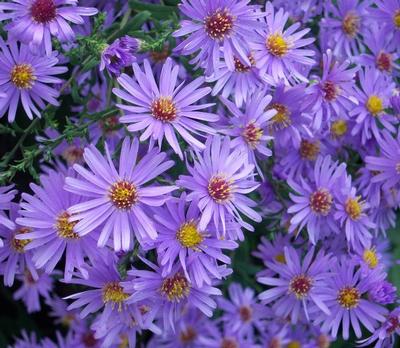New Moon Nurseries
Aster cordifolius 'Little Carlow'
Little Carlow blue wood aster
Native to North America (cultivar)
FIRST IMPRESSIONS: Aster cordifolius ‘Little Carlow’ is an attractive upright aster cultivar. Heart shaped leaves form at ground level and provide a nice groundcover in spring. In early to mid-fall myriads of daisy-like asters cover the plant. Flowers are a bright violet-blue with yellow centers and are attractive to bees, skippers and butterflies. Plants prosper in sunny or partly sunny sites with average garden soil.
HABITAT & HARDINESS: The range of the parent species, Aster cordifolius, extends from Canada south to the Florida Panhandle and west to Oklahoma. Plants occur in open woods, clearings, along creek banks, deciduous woodland edges and in disturbed roadsides and ditches.
‘Little Carlow’ was named in the 1930’s in England by a Mrs. Thornley who was an aster breeder from Devizes, Wiltshire. The cultivar is possibly a cross between Aster cordifolius and Aster novi-belgii. The selection is noteworthy for its showy intensely colored flowers and long season of bloom.
Plants are hardy from USDA Zones 4-8.
PLANT DESCRIPTION: Aster cordifolius ‘Little Carlow’ is an erect warm season perennial that branches in the plant’s upper half.
Lower leaves are up to 5” long, dark green and heart shaped. Upper leaves are smaller and ovate.
Branched flower panicles appear in late summer and bloom through fall.
The individual flower heads are composed of a ring of bright lavender petal-like ray flowers surrounding a central cluster of yellow disc flowers. The heads are produced in profusion and are about 1” in diameter.
Plants grow 1.5-2’ tall with a 2’ spread.
CULTURAL & MAINTENANCE NEEDS: Aster cordifolius ‘Little Carlow’ grows best in full sun or part sun. Plants tolerate some shade but in dense shade, stems may weaken and arch or bend.
To encourage strong stems, cut plants back in early summer to about half of the original height.
Plants grow best in average or moist sandy or clay soils. In extreme drought or very dry sites, ‘Little Carlow’ benefits from irrigation.
This is a mildew resistant cultivar that is somewhat unpalatable to deer. Plants may be nibbled by rabbits. Plants can have issues with rust especially in extremely wet weather or if overhead irrigation is over-used.
LANDSCAPE USES: ‘Little Carlow’ is a good choice for a Perennial Border or Naturalized Garden. Plants are also used as Butterfly Nectar Plants or as part of a Grouping or Mass Planting. This cultivar has Showy Blooms and can also be used in Cottage Gardens, Water-wise Landscapes, Low Maintenance Plantings and Meadows.
COMPANION & UNDERSTUDY PLANTS: Try pairing Aster cordifolius ‘Little Carlow’ with Andropogon gerardii, Amsonia hubrichtii, Eupatorium colestinum and Solidago rugosa ‘Fireworks’.
Aster laevis ‘Bluebird’ has similar height, flower color and habitat needs and can be substituted if needed.
TRIVIA: Aster cordifolius 'Little Carlow' was a favorite of the late Christopher Lloyd and was extensively planted in his garden at Great Dixter.
In 1993 Aster cordifolius 'Little Carlow' was awarded the RHS Award of Garden Merit.
English gardeners practice the “Chelsea Crop” on asters and other perennials that tend to get leggy. In early summer (late May – early June) around the time of the Chelsea Flower Show, the stems are pruned back by half or so. This procedure promotes strong stems, dense foliage and numerous small flowers.
Height:
18-24 inSpread:
24 inSpacing:
18 inUSDA Hardiness Zone:
4-8Bloom Color:
BlueAster cordifolius 'Little Carlow' Characteristics
Attracts Wildlife
- Butterflies
- Pollinators
Attributes
- Naturalizing
- East-Coast Native
- Cut Flower
- Clay Soil
Exposure
- Full Sun to Partial Shade
Flowering Months
- September
- November
- October
Foliage Color
- Green
Juglans nigra Tolerance (Black Walnut)
- Yes
Salt Tolerance
- Medium
Season of Interest (Foliage)
- Summer
- Spring
Soil Moisture Preference
- Moist to Dry
